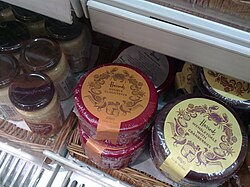| Gloucester | |
|---|---|
 | |
| Country of origin | England |
| Region | Gloucestershire |
| Source of milk | Traditionally from Gloucester cattle |
| Pasteurised | Traditionally no |
| Texture | semi-hard |
| Aging time | 36 weeks |
| Certification | Single Gloucester: PDO |
| Named after | Gloucester |
Gloucester is a traditional, semi-hard cheese which has been made in Gloucestershire, England, since the 16th century. There are two varieties of the cheese, Single and Double; both are traditionally made from milk from Gloucester cattle. Both types have a natural rind and a hard texture, but Single Gloucester is more crumbly, lighter in texture and lower in fat. Double Gloucester is allowed to age for longer periods than Single, and it has a stronger and more savoury flavour. It is also slightly firmer. The wild flower Galium verum, known colloquially as lady's bedstraw, was originally responsible for the distinctively yellow colour of Double Gloucester cheese.[1]
In the United Kingdom today, Double Gloucester is more widely sold. Both types are produced in round shapes, but Double Gloucester rounds are larger. Traditionally whereas the Double Gloucester was a prized cheese comparable in quality to the best Cheddar or Cheshire, and was exported out of the county, Single Gloucester tended to be consumed within Gloucestershire.
Most Double Gloucester sold in UK supermarkets is slab cheese, made in large creameries operated by major dairy companies such as Dairy Crest. Supermarkets normally sell Double Gloucester under their own store brand. This version of the cheese is pasteurised, but not processed.
- ^ Howard, Michael A. (1987). Traditional Folk Remedies: A Comprehensive Herbal. Random House of Canada. pp. 163–. ISBN 0-7126-1731-0.